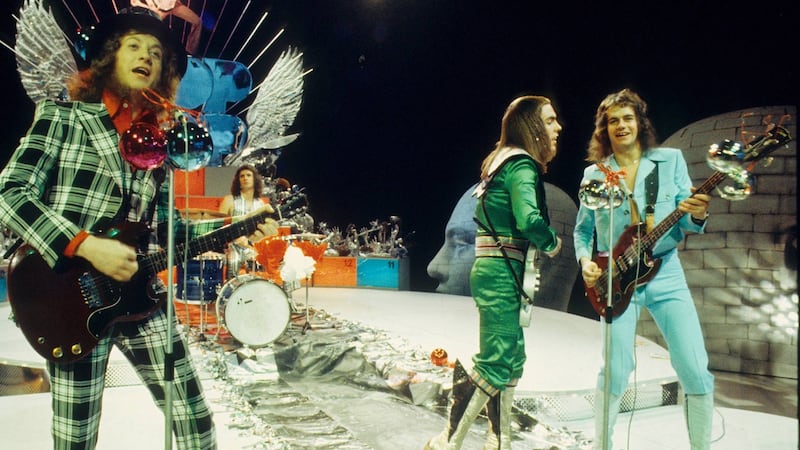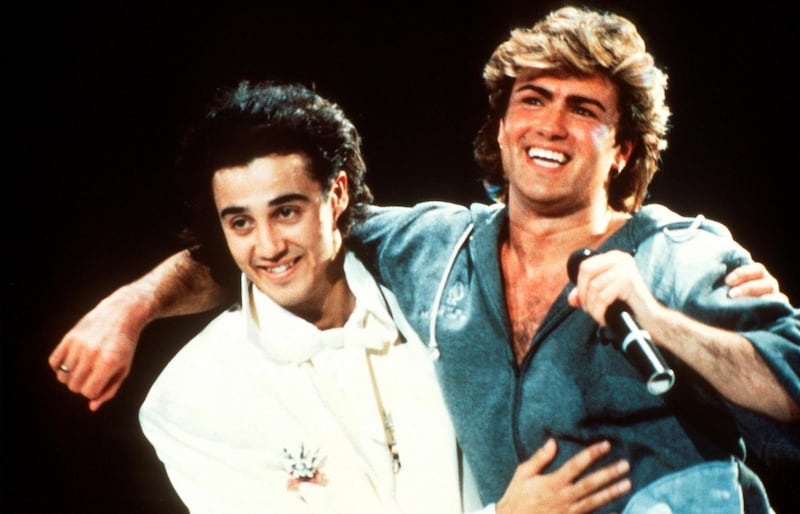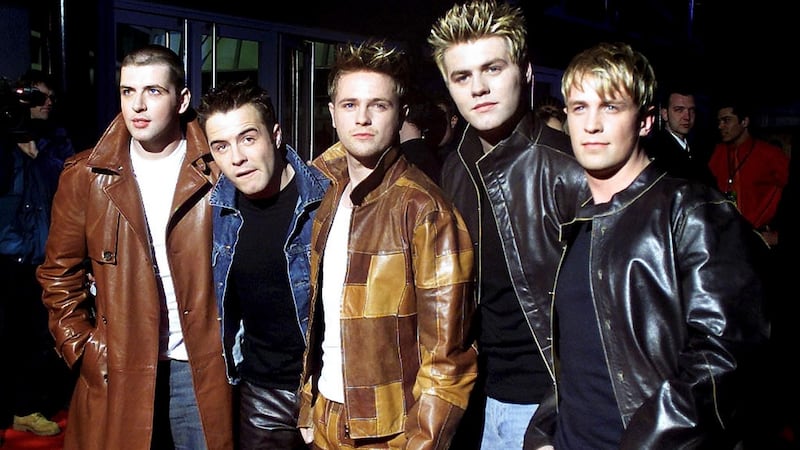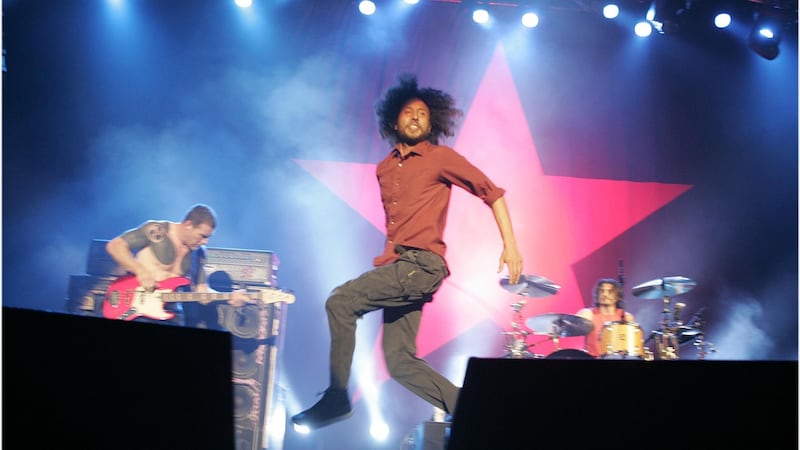Slade v Wizzard (1973)
"The rivalry erupted in a custard-pie fight" – Dave Hill, guitarist, Slade

In 1973, we had two consecutive singles enter the chart at No 1, which no one had done before. Then our drummer, Don Powell, had a horrific car accident in which his girlfriend was killed. It was really hard for months. Shortly before that, [bassist] Jim Lea's mother-in-law had asked: "Why doesn't anyone write Christmas songs any more?". So, here came the idea for Merry Xmas Everybody.
The “So here it is” chorus was rewritten from an old song of [singer] Noddy Holder’s that Jim remembered; Jim came up with the tune of the verse in the shower. Noddy wrote the lyrics at his dad’s house on a council estate in Walsall. He’d had a few bevvies and thought: “What do people do at Christmas?” and wrote about people gathering and your granny going: “The old songs are the best.”
We went to the US to do some low-key shows to see if Don could still play drums – recording the song was part of his rehabilitation. It was July in New York, baking hot, and we were in the corridor with a microphone singing: “So here it is merry Christmas.” Passersby were going: “Why are these English guys singing about Christmas in this heat? Are they crazy?” When Don overdubbed the shuffling drumbeat, it came alive.
We were in Europe when the head of the Belgian record company invited us in to hear the 7-inch. It was 10am, our wives were with us, he was pouring champagne and everybody was pissed, going: "This sounds bloody great." On the Lift Off With Ayshea TV show, Ayshea Brough, Roy Wood's girlfriend, told us Wizzard had done a Christmas song. We went: "So have we."
We'd known Roy since his Move days and there was always rivalry between us Black Country bands and the Birmingham groups. Wizzard's I Wish It Could Be Christmas Every Day was a great song, but we were at the peak of Slademania. Also, Britain had a three-day week, powercuts, telly went off at 10pm. Lyrics such as "Look to the future now" cheered everybody up.
It sold more than one million copies and went straight to No 1. Roy's went to No 4. The friendly rivalry erupted in a custard-pie fight on Top of the Pops. We pied Roy on camera – he carried on singing with custard in his beard. Then, when we were on, one of the Wizzard guys put one right in Noddy's face.
Wham! v Band Aid (1984)
"George played everything, even the sleigh bells" – Chris Porter, engineer, Wham!

The first time I heard Wham!'s Last Christmas was on a sketchy cassette demo, which George had made in his childhood bedroom. It was an incredibly busy period for Wham! and the hectic schedule meant there was little time to discuss the music before going into the studio, but I remember thinking that it was a charming and catchy tune. The lyrics – about an unrequited love that the person accepts is incurable ("I know you'd fool me again") – were an interesting story not often found in Christmas songs.
George and I recorded Last Christmas at night in Advision Studios, assisted by Avril Mackintosh and Paul Gomersall. It was the middle of August, but Paul decked out the control room with Christmas decorations.
George played everything, even the sleigh bells. I suppose it’s every writer’s dream to have a Christmas hit. I wasn’t involved in the video shoot, but the fun and snowball fighting really captures the atmosphere of that halcyon period. George and Andrew [Ridgeley] were glowing from great success and unaware of all the pressures of stardom.
A few weeks later, I was working on other Wham! material in Sarm's Studio 2 in the week that Band Aid's famine-relief single Do They Know It's Christmas? was being put together in Studio 1. I witnessed the lineup of huge stars trooping through the doors: Bono, Sting, Paul Weller – it was a real "who's who" – and, obviously, George. At the time, nobody predicted the huge success of the Band Aid single, though the considerable talent involved should have given us a clue that Last Christmas might have to make do with No 2.
George’s commitment to charitable work has been well documented; I’m sure in hindsight he would not begrudge the fact that Last Christmas was the highest-selling UK single to have never been No 1. At the time, I’m sure it rankled just a bit.
Mike Flowers Pops v Michael Jackson (1995)
"I started getting hate mail" – Michael Roberts AKA Mike Flowers, singer

At the height of grunge and Britpop, everything was very dressed down, parkas and jeans – so I conceived the Mike Flowers Pops as the opposite. The name was a nod to the easy-listening label MFP – Music for Pleasure – at a time when easy listening, which I loved, was seen as elevator muzak. I raided jumble sales for the mod suit and found a Purdey wig in a Family Welfare Organisation charity shop. I think the original wearer was female, but I parted it to the side. My mum said: “Oh Michael, you’ve got such a lovely voice. Why do you have to wear a wig?” But we went down a storm in a tent at Reading festival.
Radio 1 DJ Kevin Greening came to a gig and commissioned us to record Oasis's Wonderwall. I was barely aware of contemporary pop and had no idea it was an era-defining song, but Chris Evans made our single his record of the week and said it was the "long-lost original version". Noel Gallagher had to deny that Oasis's version was a cover, which was hilarious.
I was interviewed by Jeremy Paxman on Newsnight about the "so-called easy-listening revival". I drank half a bottle of whisky before going on and he went: "But surely Burt Bacharach and all this is rubbish?" Which no one would say now.
Our version was played on Radio 1 and 2. Kids loved it because I looked like a dork and older people were reminded of Bacharach. It appealed because it took the piss, which British people love. Our big competitor was Michael Jackson's Earth Song, which Jarvis Cocker would sabotage at the Brits a few months later. It had a lot of money behind it and, as the battle for No 1 hotted up, I started getting hate mail from Oasis fans and Jacko fans. Someone called me the antichrist.
Keeping Jackson off the top would have been very funny, but in the end I was almost relieved that we finished No 2 – the tabloids even phoned me at my mum’s on Christmas Day.
I met Noel once in the street in London and he was very friendly. He said: “Your version bought me a new swimming pool.”
Bob the Builder v Westlife (2000)
"It was being chanted at football matches" – Paul Joyce, songwriter, Bob the Builder

I'd been in a synthpop band called Sense but after it didn't take off, I moved into films and TV. Coming up with a theme tune for kids' programme Bob the Builder was a paid job, but I put a lot into it. I didn't want some trite thing that rhymed with "builder".
Because it was for kids, the words couldn’t be complicated and had to be easily sung. The phrase: “Can we fix it? Yes we can” was in the show, but I split it up so there’s a sense of tension – the pause before the “Yes we can”. I made a demo with my family all singing on it and the programme said: “We want it to be more lads-y.” So I put on walls of guitars. It wasn’t a typical song for under-sixes.
Shortly after Can We Fix It? was first broadcast, I was walking down a street in Nottingham at about 11pm and these beery lads were chanting: "Bob the Builder! Can we fix it?" Then it was being chanted at football matches – the single just kept building.
Westlife and All Saints were Bob’s big competitors: two of the biggest names in pop music up against a cartoon builder. It was ridiculous, but incredible. I did a guest appearance at my local school and, as soon as the music went on, all these kids just went crazy, singing all the words at me with unbridled passion. It was sensational.
I was so Bob-centric at the time that I can't remember the Westlife track, What Makes a Man – I certainly couldn't sing it now. But they were an unassailable pop phenomenon. Although Bob had the surprise factor, I don't think the band or their fans thought they could be challenged by a cartoon brickie. When we went to No 1, Sky TV interrupted Christmas dinner for an interview. I thought: "This will never happen again," and it didn't, but I still get royalties every year. It will probably say "Can we fix it?" on my tombstone.
The Darkness v Gary Jules (2003)
"It ruined my holiday and then ruined my Christmas" Justin Hawkins, singer-songwriter, the Darkness

In 12 months, we had gone from playing to literally no audience in Sheffield to Darknessmania. The label kept pestering us for our next move. Being a bit contrary, we asked ourselves: “What’s the last thing we should do? Record a Christmas single!” Nobody seemed to make them any more, but I’d grown up with Christmas songs on Top of the Pops. A lot are actually quite sad, but you’re strangely comforted by the log fire and the awful Christmas jumper.
So we decided to combine a sad verse with a really uplifting chorus. The next thing we knew we were in Abbey Road, recording Christmas Time (Don't Let the Bells End). My brother [Dan, guitarist] made the studio Christmassy, with a tree, decorations, and – ahem – artificial snow on most of the flat surfaces. We did the track, went off to the Kerrang! awards to win some trophies, then came back to the studio hungover. That was what our lives were like then.
The song includes several double entendres, which ended up even naughtier on the recording. In order to simplify the vowels and consonants, the children’s choir had to sing “bellend” and “ring peace”. They’re only naughty if you find that sort of thing amusing, which our audience did.
Gary Jules was our big competitor, with his cover of Tears for Fears' Mad World from Donnie Darko. It was almost an anti-Christmas record, but Radio 2 played it constantly and it had massive exposure in the film. After our last show of the year, in Paris, I stayed in France for a Christmas holiday, but was summoned back to London to do promo because we were at No 1 in the midweeks [charts], but Gary was catching us up. In the end, he overtook us so, having ruined my holiday, that ruined my Christmas – although having a No 2 was still incredible. I met Gary at an airport and he was really nice. He jokingly apologised.
Joe McElderry v Rage Against the Machine (2009)
"I don't think people were enjoying their Christmas dinner listening to Killing in the Name" – Joe McElderry, singer

I first auditioned for The X Factor when I was 15 and won the show when I was 18. For the final, I stood behind the double doors with Simon Cowell, Olly Murs and Cheryl [Cole]– I can't remember anything from that moment onwards. It was like this huge surge of nerves and energy, then you're sat alone in your hotel room thinking: "What just happened?"
I came off the show and was plunged straight into the schedule of promoting the single. I’d had about four hours sleep over the whole weekend, and suddenly I had all these people explaining what a midweek chart position was.
My song, The Climb, had been chosen for me, but I liked the message about overcoming obstacles, which ironically turned into a prophecy. People started saying: "Just so you're aware, there's this campaign on the internet to get Rage Against the Machine's Killing in the Name to No 1 to keep the X Factor single off." I didn't take it personally. I knew it was directed at Simon and the show.
Twitter was a new thing, Facebook was big and they had the leverage. It was a brilliant publicity stunt. I'd never heard of Rage or the song [chorus: "Fuck you, I won't do what you tell me"] and I'm sure they'd never heard of me. It was the least Christmassy record ever, but I don't think anyone who bought that song to stop the X Factor single would be sitting down for their Christmas dinner with their grandma listening to Killing in the Name. They beat me, but it was close. I actually got a call telling me I was No 1. We held off the champagne because we'd been watching the numbers and it didn't feel right. Then they phoned back to say: "Sorry, we made a mistake." But I was an 18-year-old boy who'd dreamed of this career, and had got to No 2 – I was buzzing anyway.
The public got behind me and a week later we got to No 1 on New Year’s Eve, so it worked out quite well. – Guardian









